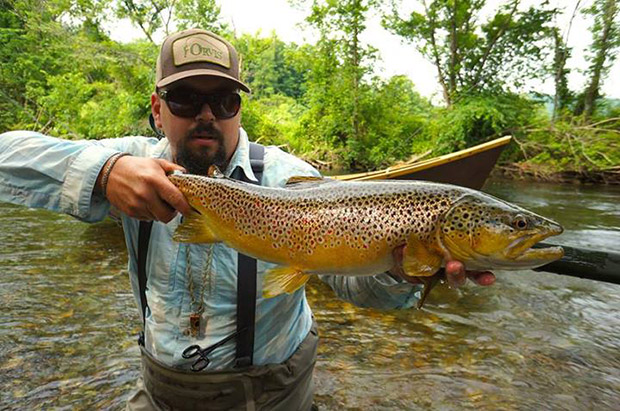
Written by: Phil Monahan, Orvis News
The brown trout (Salmo trutta) has earned a reputation as the wariest and wiliest opponent a river angler can face. Whereas a brookie or a cutthroat will often attack flies with gullible abandon, browns are usually more discriminating. The larger specimens, especially, are often reclusive—hiding beneath a cutbank or hunkering near the bottom until darkness falls, and only then emerging to hunt baitfish. Because of these sporting qualities, the species has been stocked in waters well outside its range, a result of the recreation craze and empire-building of the 19th Century. In fact, the British were so determined to bring the brown trout to Tasmania that they made three attempts to ship trout eggs around the African continent, finally succeeding in 1864. Fly fishers can now test their wits against browns on six continents.
Range and Species History
The original range of the brown trout is much larger than most anglers realize, reaching from northern Norway and the White Sea tributaries of Russia south to the Atlas Mountains of North Africa. The species ranged west as far as Iceland and as far east as the Aral Sea tributaries in Afghanistan and Pakistan. Of course, there are now wild, self-sustaining populations of brown trout in places such as New Zealand, South America, and South Africa.
The species first came to the U.S. in 1883, when a New York fish farmer named Fred Mather imported brown-trout eggs from Baron Lucius von Behr, president of the German Fishing Society. (That’s why many folks refer to the fish as German browns.) Two years later, eggs from Scotland’s Loch Leven arrived and were sent to the same three hatcheries, and the prevailing theory is that the genetic stock were mixed to create what Robert Behnke calls the “American generic brown trout.” In 1884, the release of 4,900 brown-trout fry into Michigan’s Baldwin River, a tributary of the Pere Marquette River, represented the first time the species swam free in U.S. waters.
Although there are currently no recognized subspecies of brown trout, there are three basic morphs (distinct behavioral populations within a species): those that in habit freshwater rivers (Salmo trutta morpha fario), lake populations (Salmo trutta morpha lacustrine), and anadromous forms (Salmo trutta morpha trutta). Browns that spend their lives in the ocean before entering rivers to spawn are called sea trout. The species name means “salmon trout” and described the anadromous morph. Resident and anadromous browns that inhabit the same river are genetically identical, and biologists do not yet understand why some migrate to the salt and some stay in the river.
Go to Orvis News for complete story and images.



